Atlantic Salmon Identification
Since 1997, when the club started to get
involved with stocking Atlantic salmon, people have been catching
some of the salmon we have stocked in Fish Creek. There seems to
be some confusion among anglers related to being able to
distinguish Atlantic salmon from brown trout. Atlantic salmon are
easily identified as Atlantics by two main features.
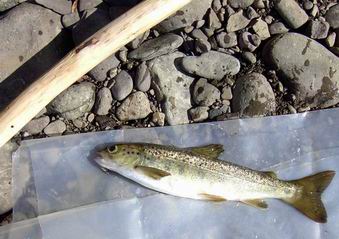
click
on image for high resolution image |
Distinguishing features of Atlantic salmon
are the short face of the fish and the length of the mouth. Atlantics
have a smaller mouth than do brown trout. Notice the forked tail and
the narrowing of the body just before the tail.
This is an example of a juvenile Atlantic
salmon that might be found in area streams. This fish is beginning to
smolt (that is: it is losing its camouflage markings and taking on a
silvery sheen in preparation to living in a lake or the ocean. Notice
that the parr markings are beginning to fade. (Parr marks are those
vertical dark bands on the side of the fish.)
|
| After living in a stream for two years they
become smolts, lose their parr marks and become silvery in preparation
to live in a bigger body of water. This Atlantic salmon was recovered
in the summer of 2001 by the Cornell Extension at Shackleton Point.
Notice the shape of the fish and the narrowness of the body immediately
in front of the forked tail. Also noticeable is the short nose and the
small mouth. There are few spots below the lateral line. This is
probably a 3 year fish that grew up in Fish Creek and came downstream
to live in Oneida lake. |

click
on image for high resolution image |
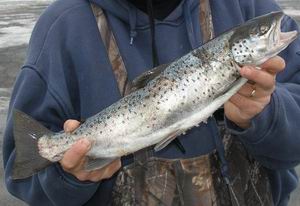 |
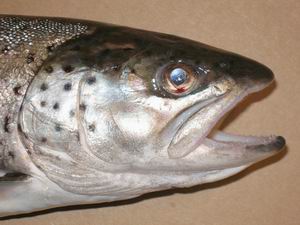 |
| In the past club members have heard many
reports about Atlantic salmon being caught in Oneida lake by ice
fishermen. This is the first one verified and photographed by the club.
It measured 18 inches. |
A distinguishing feature of
Atlantic salmon
is the relatively small mouth. If you were to draw a vertical line from
the rear edge of the eye it will usually pass entirely behind the mouth. |
By examining the inside of the mouth we can
more exactly tell whether the fish is an Atlantic salmon or a
brown trout. The Atlantic salmon has on the roof of its mouth a
single row of vomerine teeth. The brown trout on the other hand
has two rows arranged in a zig-zag fashion. In addition the
tongue on the Atlantic salmon is tapered and narrow whereas the
tongue of the brown trout is broad and square. In the diagram
below "A" is pointing at the Vomerine head and
"B" is pointing at the Vomerine shaft.
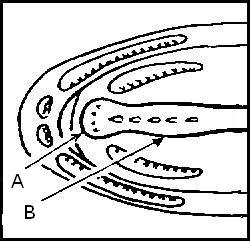
A. Vomerine head
B. Vomerine shaft |
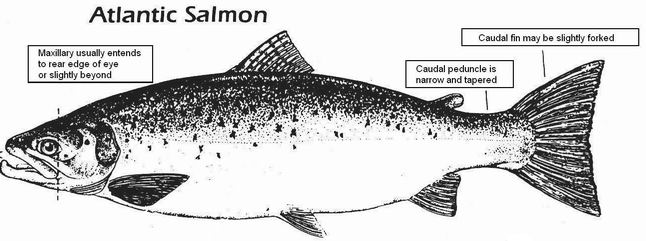 |
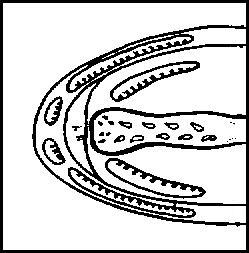 |
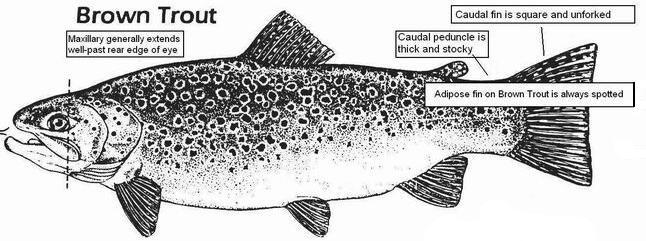 |
Ocean Going Atlantic Salmon
As part of the smolting process
the ocean-going Atlantic will
be able to live in a salt water environment. The body fluids of a
salt water fish has a salt concentration about 1/3 that of sea
water. Water tends to flow outward to equalize the concentration
of salt. Compensation is made by the marine fish by drinking sea
water and not urinating. Special cells called salt cells are used
to excrete salt back into the sea. In contrast a freshwater fish
will produce a large dilute urine flow and will replenish lost
salt by absorbing salt through the gills from fresh water.
This process starts in the
fresh water and continues until the
fish enters the sea. The first part of the smolting process is
the change coloration. The Atlantic goes through a physiological
change of the kidneys, gills, intestine and hormonal system to
allow body salt to be secreted back into the sea.
As the salmon gets into more
brackish water it starts drinking
water and stops urinating. Growth hormones will stimulate
development the chloride cells in the gills to allow the fish to
excrete salt. Hormones, cortisol and thyroxin, stimulate the body
to excrete salt and retain water. If the fish does not reach the
sea then there is a regression of these changes
An Atlantic salmon returning
back to fresh water from the sea
has to undo the changes made as a smolt in order to survive in
freshwater. Not much is known about this process.
Back
to Home

